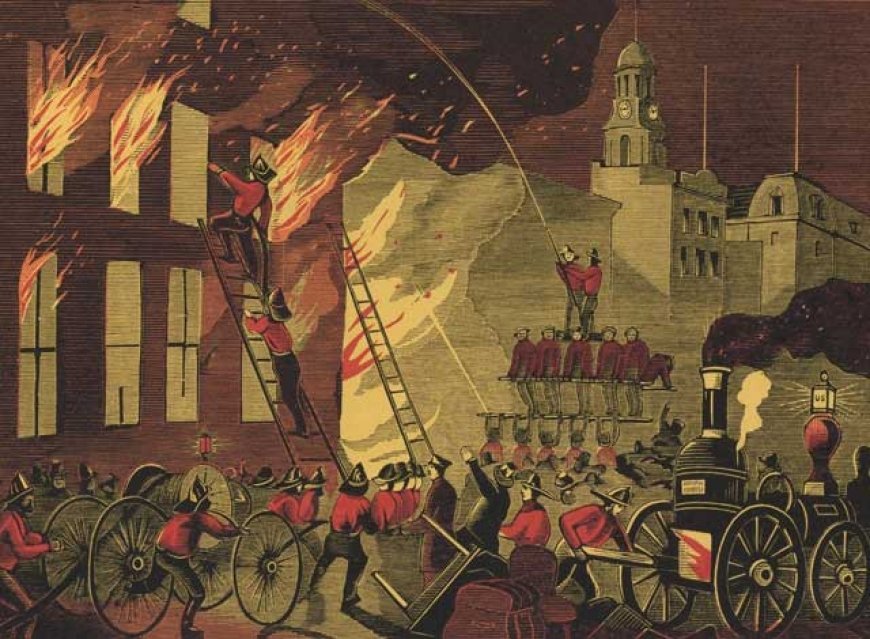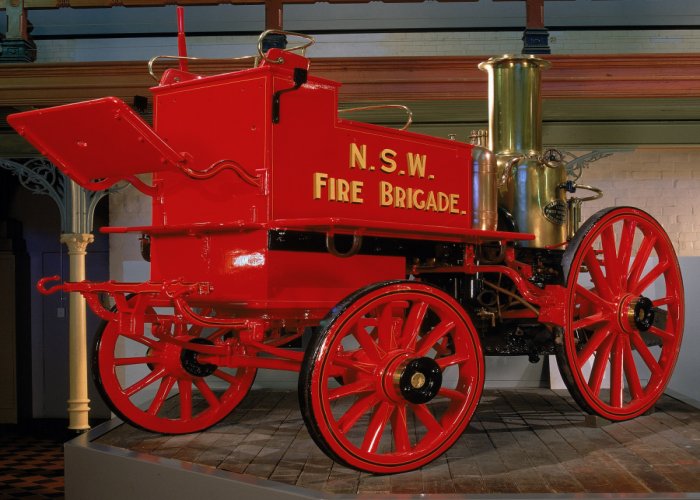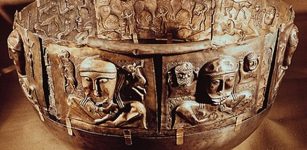Ancient Inventions Of Firefighting Vehicles
A. Sutherland - AncientPages.com - The city of Alexandria, Egypt had the first primitive device that was used to spray water was used in the city of In the third century BC., the ancient inventor Ctesibius, a Greek inventor and mathematician, made a pump; it was later improved by Heron in the first century B.C.
The remains of such a pump have been found both in Italy and in England.

Streets of New York. TS 240.12.1.69 (A), Harvard Theatre Collection, Houghton Library, Harvard University
In Rome, was a group of slaves, carrying around these advanced (for the time) pumps. The slaves called the Familia Publica, represented "the fire department" in Rome.
The Roman fires were violent and widespread so the slaves were usually slow to respond, guaranteeing their own safety. In the year 6 AD, almost 30 percent of Rome burned in a very large series of fires. Emperor Augustus decided that this was much too high a cost, so he assembled a team of public firefighters, named the Vigiles.
In America, it was required that each house had a bucket of water on the front stoop during fires at night. The buckets were intended for use by the initial bucket brigade that would supply the water at fires. In 1719, Philadelphia obtained a hand-pumped fire engine and another model of this engine was used in Boston several years earlier.
See also:
First Odometer Was Invented By Vitruvius Around 15 B.C.
The earliest engines were small and were either carried by four men, or mounted on skids and dragged to a fire. As the engines grew larger they became horse-drawn and later self-propelled by steam engines.

Steam fire engine pumper made by Merryweather and Sons, Greenwich, England, 1895. Powerhouse Museum collection. B1406.
Two engines arrived to New York from London and on February 5, 1830, John Ericsson invented the first American steam-powered fire engine and in 1829, John Braithwaite (1797–1870), an English engineer invented the first steam fire engine.
In England in the sixteenth century, there were so-called "hand squirts." These "squirts" were of very limited effectiveness for their capacity was only about two to four quarts of water, and usually, three men were required to operate them -- two to hold the cylinder and one to work the plunger. Other people had to help in carrying to carry the water.
In the course of time, there was developed the "man-power" pumping engine with the rocking handle operated by two or more men, and mounted on a four-wheeled carriage drawn by men.
This type of engine, which was improved upon from time to time, was used for many years. A few pieces of this type are still in existence.
Written by – A. Sutherland - AncientPages.com Senior Staff Writer
Copyright © AncientPages.com All rights reserved. This material may not be published, broadcast, rewritten or redistributed in whole or part without the express written permission of AncientPages.com
Expand for referencesMore From Ancient Pages
-
 Elizabeth Woodville: Mother Of The Princes In The Tower And Commoner Queen
Featured Stories | Jul 16, 2018
Elizabeth Woodville: Mother Of The Princes In The Tower And Commoner Queen
Featured Stories | Jul 16, 2018 -
 Native American Tradition Of A Vision Quest – How To Enter The Spiritual World
Ancient History Facts | Apr 25, 2017
Native American Tradition Of A Vision Quest – How To Enter The Spiritual World
Ancient History Facts | Apr 25, 2017 -
 Legend Of Baku – The Dream Eater – Was It An Ancient Supernatural Being?
Featured Stories | Feb 15, 2023
Legend Of Baku – The Dream Eater – Was It An Ancient Supernatural Being?
Featured Stories | Feb 15, 2023 -
 Mama Quilla – Incan Moon Goddess Of Marriage And Fertility Assisted By High Priestesses Of Qoricancha
Featured Stories | Jun 15, 2020
Mama Quilla – Incan Moon Goddess Of Marriage And Fertility Assisted By High Priestesses Of Qoricancha
Featured Stories | Jun 15, 2020 -
 Dorset Culture: Mysterious Rock Carvings Of Qajartalik – Faces Of Unknown Beings
Civilizations | Sep 3, 2018
Dorset Culture: Mysterious Rock Carvings Of Qajartalik – Faces Of Unknown Beings
Civilizations | Sep 3, 2018 -
 Gundestrup Cauldron: Great Gilded Silver Vessel Decorated With Scenes Derived From Celtic Mythology
Artifacts | May 30, 2016
Gundestrup Cauldron: Great Gilded Silver Vessel Decorated With Scenes Derived From Celtic Mythology
Artifacts | May 30, 2016 -
 Sumerian ‘Mask Of Warka’ From Uruk: Sculptured Face May Depict Goddess Inanna
Featured Stories | Sep 15, 2016
Sumerian ‘Mask Of Warka’ From Uruk: Sculptured Face May Depict Goddess Inanna
Featured Stories | Sep 15, 2016 -
 Hoysaleswara Temple: Great Supporter Of Most Powerful Traditions Of Hinduism
Featured Stories | Jun 21, 2021
Hoysaleswara Temple: Great Supporter Of Most Powerful Traditions Of Hinduism
Featured Stories | Jun 21, 2021 -
 Skirnir’s Mission To Jotunheim To Gain Gerda For Lovesick God Frey
Featured Stories | Mar 14, 2020
Skirnir’s Mission To Jotunheim To Gain Gerda For Lovesick God Frey
Featured Stories | Mar 14, 2020 -
 Secret Ancient Knowledge Of The Druids And The Mystery Of The Missing Library Of Iona
Artifacts | Sep 4, 2016
Secret Ancient Knowledge Of The Druids And The Mystery Of The Missing Library Of Iona
Artifacts | Sep 4, 2016 -
 Gigantic Karnak Temple Complex: Advanced Ancient Technology In Egypt
Civilizations | Apr 6, 2017
Gigantic Karnak Temple Complex: Advanced Ancient Technology In Egypt
Civilizations | Apr 6, 2017 -
 Ancient Egyptian Knowledge Of The Cosmic Engine And Unseen God Of The Universe
Featured Stories | Jan 15, 2019
Ancient Egyptian Knowledge Of The Cosmic Engine And Unseen God Of The Universe
Featured Stories | Jan 15, 2019 -
 Bizarre Sandstone Towers Of The Rocky Town And Legend Of Jan Svatos Who Mastered Magic
Featured Stories | Sep 8, 2018
Bizarre Sandstone Towers Of The Rocky Town And Legend Of Jan Svatos Who Mastered Magic
Featured Stories | Sep 8, 2018 -
 Real Giant Kojomkul Who Became A Folk Hero In Kyrgyzstan
Featured Stories | Dec 2, 2020
Real Giant Kojomkul Who Became A Folk Hero In Kyrgyzstan
Featured Stories | Dec 2, 2020 -
 The Mystery Of Serpent Worship
Featured Stories | Jun 25, 2019
The Mystery Of Serpent Worship
Featured Stories | Jun 25, 2019 -
 Trialeti Culture: Ancient Caucasian People Who Still Hold Their Secrets
Civilizations | Jul 8, 2017
Trialeti Culture: Ancient Caucasian People Who Still Hold Their Secrets
Civilizations | Jul 8, 2017 -
 Mysterious Ancient Shapeshifters Who Guided Humans And The Battle Of The Gods Described In Sacred Texts And Myths
Featured Stories | Oct 27, 2021
Mysterious Ancient Shapeshifters Who Guided Humans And The Battle Of The Gods Described In Sacred Texts And Myths
Featured Stories | Oct 27, 2021 -
 Riddle Of The Ancient Sarcophagus And Its Strange Properties – Can Science Solve This Mystery?
Featured Stories | Nov 7, 2019
Riddle Of The Ancient Sarcophagus And Its Strange Properties – Can Science Solve This Mystery?
Featured Stories | Nov 7, 2019 -
 The Red Dragon Of Wales – Ancient Symbol Dating Back To Roman Times
Ancient Symbols | Jan 3, 2018
The Red Dragon Of Wales – Ancient Symbol Dating Back To Roman Times
Ancient Symbols | Jan 3, 2018 -
 Naglfar Nail-Ship Carries Demonic Forces To Ragnarok In Norse Beliefs
Featured Stories | Aug 10, 2020
Naglfar Nail-Ship Carries Demonic Forces To Ragnarok In Norse Beliefs
Featured Stories | Aug 10, 2020
